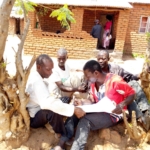


University of Malawi
Malawi
9/2006—9/2010
Rural populations throughout the Southern and Eastern Africa are facing rising food insecurity due to increasing pressure from the devastating HIV-AIDS epidemic, climate change, degradation of the soil-resource base and poverty. Malawian smallholder farmers are amongst the most affected. Eighty percent of Malawi’s population is highly dependent on their own agricultural production to meet their household needs for food and income. The majority of rural smallholder farmers cultivate between 0.5 – 1.0 hectare of land. While 70-80% of the agricultural landscape is devoted to maize, the staple crop, smallholder farmer’s average maize yields are in decline. This is primary due to nutrient-related soil constraints and farmers economic inability to invest in external inputs for soil improvement. There is a strong relationship between soil fertility, agricultural productivity, crop diversity and malnutrition. To improve food security and the nutritional status of their families, Malawian farmers need to understand these relationships and learn ways of cultivating their land both more sustainably and intensively.This project is being implemented in Northern Malawi at Ekwendeni, and in Central Malawi at Kasungu. An innovative team of non-governmental partners and farmer research and extension teams have partnered with researchers to investigate legume diversification options for improved soil nutrition and family health; and participatory technology development approaches. Nutrition education with farm families’ has markedly enhanced interest and farmer experimentation with legumes such as pigeon pea (Cajanus cajan) intercropped with groundnuts, and Mucuna.A baseline survey was carried out with 46 farmers, including documentation of cropping systems, farmer utilization of legumes, and soil sampling.An on-farm soil test kit provided immediate soil pH and texture results to facilitate discussions with farmers and soils were collected for laboratory analyses – Initial results have documented low soil fertility, and a wide range of soil texture and organic matter characteristics among participating farmer field sites.94% of participating farmers have experimented with growing the multipurpose legume pigeonpea in Ekwendeni, whereas the new sites in Kasungu have few farmers currently growing pigeonpea, but many interested in experimenting with this new legume system.On-farm research trials were carried out in 2008 at 42 field sites in Ekwendeni and 32 sites in Kasungu to assess legume technologies, quantify nitrogen fixation, maize nutrition, cropping system performance and soil improvement from legume best bet technologies. Hundreds more farmers are involved in participatory action research and conducted their own experimentation. The initial growing season demonstrated the high variability in rainfall that is becoming more common, and crop yield in this stressed environment ranged from 400 to 1000 kg/ha.Innovative extension underway includes nutrition education through recipe days, on-farm adaptation of legume varieties and residue management practices, and farmer-to-farmer visits. Training materials developed include 3 Extension Bulletins on Legume Technologies and 10 Farmer Flyers on Legume 4 Recipes. This provides information on how to utilize legumes, and how to manage doubled up pigeonpea-groundnut and multipurpose legume technologies. These have been developed and distribruted and they are being reviewed as part of an on-going process of iterative evaluation by multiple partners and then will be disseminated broadly. Additional training materials on compost preparation and legume recipes are planned for 2009.Research and extension plans for 2009 are to follow up for a second year of onfarm trials, quantifying nitrogen inputs from biological fixation and impact on soil organic matter fractions. Farmer assessment is on-going and an iterative process. Initial research results have been summarized and reported at farmer field days, and at other research and extension venues in Malawi and the region.Policy input: An exciting development is input into Malawi government policy on agricultural subsidies, which have been broadened to include legumes for the first time. A policy stakeholder briefing meeting is planned for February, 2009 to promote broader understanding of the soil and family nutritional benefits from legume diversified technologies.
The goal of this project is to improve Malawian families’ access to nutritious legumes while promoting sustainable farming through diversified crop species that access soil nutrients for long-term productivity.
